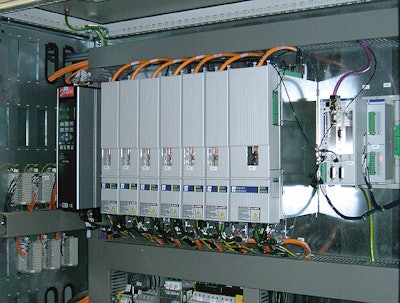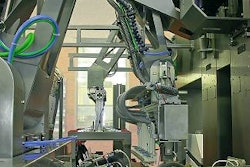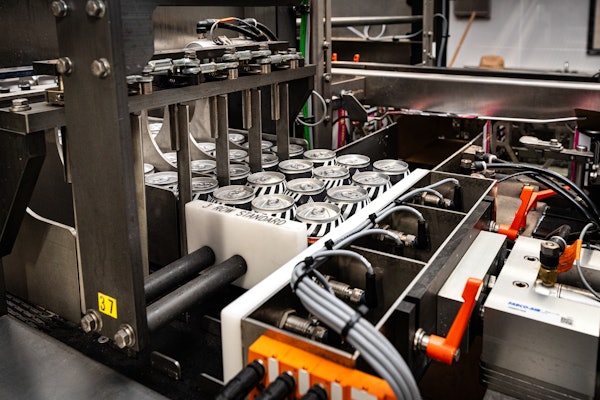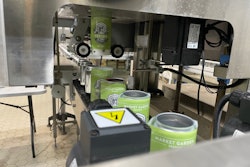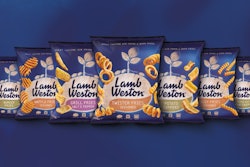At the Bad Homburg, Germany, plant of pharmaceutical products manufacturer Fresenius Kabi, increased demand for “Easy Bag” stand-up pouches of enteral nutrition products has made it necessary to add packaging capacity at a steady clip over the past five years. But only on Line 3, its newest line, has the firm solved the challenge of automatic case packing, says head of engineering Manfred Grueneberg. The solution: a 12-axis, servo-controlled, robotic case packing system from Paal Packaging Machines, a German supplier represented in the United States by Interpak LLC.
Seven axes of motion are dedicated to collating the stand-up pouches into the proper case counts. The remaining five axes of motion are in the integrated Fanuc articulating robot that picks collated pouches and puts them into cases.
“A liquid-filled pouch is not an easy thing to handle with automated equipment,” says Grueneberg. “Not only does the pouch want to fall over, it’s also fairly susceptible to damage that could cause a leak. So it wasn’t speed so much that we were looking for. It was gentle handling and reliability.”
Having said that, he adds that he’s pleased with the speed of 60 to 70 1.5-L pouches/min that the Paal system delivers. Also run on the line are 1-L and 1¼2-L pouches, the latter at 90/min. Changeover from one size to another on the computer-controlled system takes less than 30 min, says Grueneberg.
Complementing the case packing system is a Paal case erector. Positive control over case blanks at all times is the characteristic that Grueneberg most admires on the case erector. Vacuum cups pull the blanks from the magazine, and a mechanical pre-feed device greatly minimizes any chance for a misfeed to occur. The case bottom is hot melt glued before the case is turned from its side onto its bottom and conveyed into the case packer.
While freshly erected cases are indexed into the case packing system from one side, enteral pouches enter from the other. Regardless of size, these pouches are all intended for distribution through professional health care channels, not retail outlets. Patients are fed the pouch contents either through a nasal tube or a stomach shunt.
At the point pouches reach the infeed to the case packer, they’re fresh from the retort (see sidebar). They descend from an overhead conveyor by way of an alpine conveyor that sits just ahead of the case packer.
Two transfer cars
Central to the design of the Paal robotic case packing system are two partitioned transfer cars, mounted on belts, that cycle around an elliptically shaped transport system. Pouches drop from an infeed belt into the partitions of a transfer car so that one pouch rests on its gusseted bottom in each partition. When each partition has its pouch, the belt-mounted transfer car strokes forward to a position from which all the pouches can be pushed at a right angle onto a matte-top belt conveying section leading to the robotic end effector. Each transfer car moves independently yet synchronously on its own belt. So while one is being loaded, the other is being emptied.
On the day Packaging World visited Fresenius, the 1.5-L size was in production, so the Paal transfer cars were being loaded with five pouches each. Unloading of the pouches from each transfer car onto the matte-top belts that lead to the robotic picking head is done in two separate strokes. As soon as the first stroke has pushed three pouches onto the matte-top belt, the transfer car indexes forward ever so slightly along its east-west axis and the matte-top belt advances, too, along its north-south axis. Consequently, when the last two pouches are pushed forward, one nestles between the left and center pouches while the other moves into the slot between the right and center pouches. This partially nested orientation—as opposed to having the five pouches simply lined up straight across from left to right—makes it much easier for the end effector on the picking robot to close on all five pouches and lift them to a waiting case.
Servo motors’ role
Servo motors play an important role in the motion of the two white matte-top conveyor belts that deliver pouches to the robotic picker. Each of these belts is driven independently by its own servo motor. That means the first one can be driven at whatever speed is optimal for collation while the second one need only be concerned with getting collated pouches to the robotic picker. The net result, says Grunewald, is a pouch-handling system that moves pouches toward the robotic picker as fast as possible without causing any pouch to fall over.
The traffic cop coordinating the complex seven-axis pouch infeed is a Bosch Rexroth PPC, which is a combined motion and logic controller. Also essential are seven servo motors and their seven complementary drives, also from Bosch Rexroth. One servo is used for the infeed belt that meters pouches into the transport cars, two servos control the belts on which the transport cars are mounted (one for each belt), two servos control the matte-top infeed belts (one per belt), and two servos (one for a horizontal and one for a vertical axis) are used for the device that pushes the pouches from the transport cars onto the matte-top conveyor.
“All seven axes of motion are synchronized by the PPC controller,” says Peter Mueller of Bosch Rexroth. “This ensures the proper timing of all machine actions. Without this synchronization, you would have to accelerate the pouches so fast they’d become unstable and likely fall over.”
Robotic end effector
The robotic pickup uses both a mechanical clamping motion and vacuum to securely hold the pouches in its grip. Five servo motors give the Fanuc machine the multi-axis range of motion it needs to complete its task, including placement of pouches inside a case. Also, a photocell ensures that if one pouch falls over—which would prevent the robotic end effector from being able to include that pouch in its grip—all five pouches will drop into a reject bin before they reach the end effector. This helps ensure that no case leaves the plant without its full complement of pouches.
Exiting the case packing system, cases are conveyed through an ink-jet coder from Diagraph that puts a production date code on each case. Next is an Optima checkweigher to check yet again that all five bags are in the case. Tape is then applied to the top of the case by a Soco System machine. The tape includes an easy-open feature called The Zipper. It creates a small triangular tab of paper at both ends of the tape so that health professionals can grab the tab and easily open the case without having to use a sharp object that might result in a damaged pouch.
After a right-angle turn, cases proceed through a thermal-transfer print-and-apply unit. The print engine is from Zebra and the applicator from Weber.
“The production date code ink-jetted onto the case further upstream isn’t the only information needed,” says Grueneberg. “Product information and certain data that’s country-specific is what goes on the print-and-apply labels.”
All that remains is robotic palletizing by an ABB system that was installed a few years back when Line 2 went in. With the installation of Line 3, the palletizer was modified to accept cases from either line at the same time.
Further modifications and upgrades, notes Grueneberg, are on the drawing boards at the Bad Homburg plant as demand for the Fresenius Easy Bag enteral pouch continues to rise. But at least automatic case packing has now been solved.
“The Paal system has been very effective for us,” says Grueneberg, who also gives credit to the system’s controls components. “I don’t think such motion would be possible without servos.”
For a complete list of suppliers mentioned in this features, see packworld.com/go/w146
See sidebar to this article: Filling and retorting
